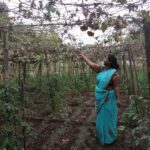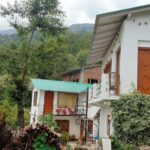In the 1960s, a local artist named Abdul Rahim Gutti introduced an intricate art form to the artisans of the ‘Chhipa’ community in Bhairavgarh, located in Ujjain district of Madhya Pradesh. Popularly known as batik art, the ancient textile craft is believed to have originated in southeast Asia about 2,000 years ago. The process involves a series of meticulous steps, including washing and sun-drying the cloth, and the precise application of melted wax using engraved wooden, copper and metal blocks. This process results in vibrant designs and diverse textures, ultimately revealed through dyeing and de-waxing, creating stunning fabrics cherished by many. Have a look.
Batik is a renowned form of textile craft that originated on the island of Java in Indonesia. The term “batik” is derived from the Javanese words “amba” meaning ‘writing,’ and “titik” representing ‘dots.’ In the 1960s, Abdul Rahim Gutti, an artist hailing from Bhairavgarh, introduced batik to the textile craftsmen of the ‘Chhipa’ community in the region.
Also Read | Weavers keep Bastar’s pata saree tradition alive
The batik process starts with the preparation of the fabric. It is first thoroughly washed and bleached to eliminate any excess starch. Once cleaned, it is left to dry under the sun. Next, the wax is melted at a high temperature to get a liquid with a flowing consistency.
The motifs are created on the cloth using wooden, copper and other metal blocks. These blocks, engraved with intricate patterns, are first immersed in the molten wax. They are carefully pressed onto the fabric to create the desired imprints.
Also Read | Arecanut goes from yucky paan stains to dandy dye
In addition to blocks, a specially designed pen is also commonly used as a traditional instrument. Brushes and brooms are employed as well, contributing to the creation of diverse textures in the artwork.
Batik is a dyeing technique that relies on the application of wax as a resist agent. After the patterns have been imprinted on the fabric, chemical and natural dyes are used to colour the non-waxed areas.
Also Read | Kashmir’s kani shawl weavers feel left out in cold
To fix the colours, the fabric is coated with wax once again. Subsequently, the entire fabric is immersed in coloured water. Once the desired colours have permeated the fabric, it undergoes de-waxing. This involves multiple rounds of dipping the fabric in boiling water to remove the wax completely, revealing the colourful design beneath.
Creating batik prints involves a meticulous process of superimposing layers upon layers. The more the layers of shades and textures, the more repetitive the waxing-dyeing-dewaxing process becomes.
Also Read | Tie and dye add color to women’s lives in Nosariya
The finished fabrics are washed in clean water to ensure the removal of any remaining impurities. Finally, they are dried under the sun. The range of batik items varies, from dupattas priced at Rs 200, all the way up to exquisite batik silk sarees that cost about Rs 40,000.
The lead image at the top shows with Hayat’s head bowed down as he focuses on painting a picture (Photo by Pranay Tripathi)
Pranay Tripathi, an Indore-based upcoming filmmaker and a Rural Media Fellow 2022 at Youth Hub, Village Square.
















